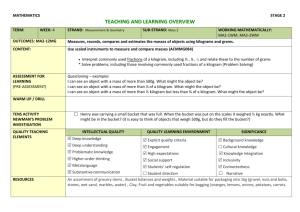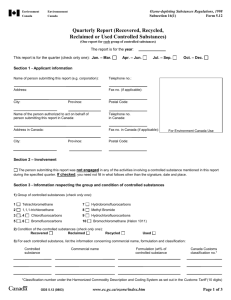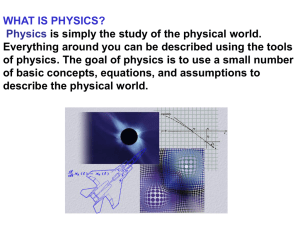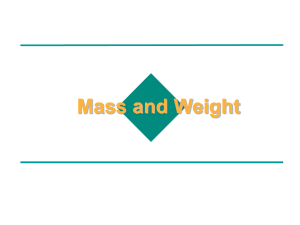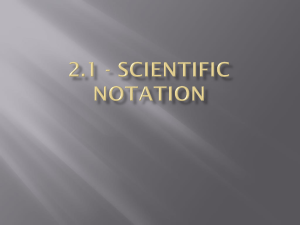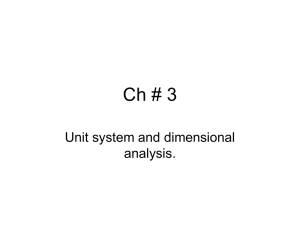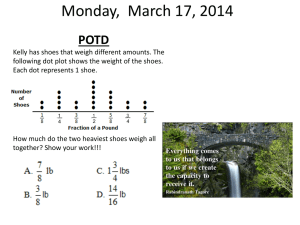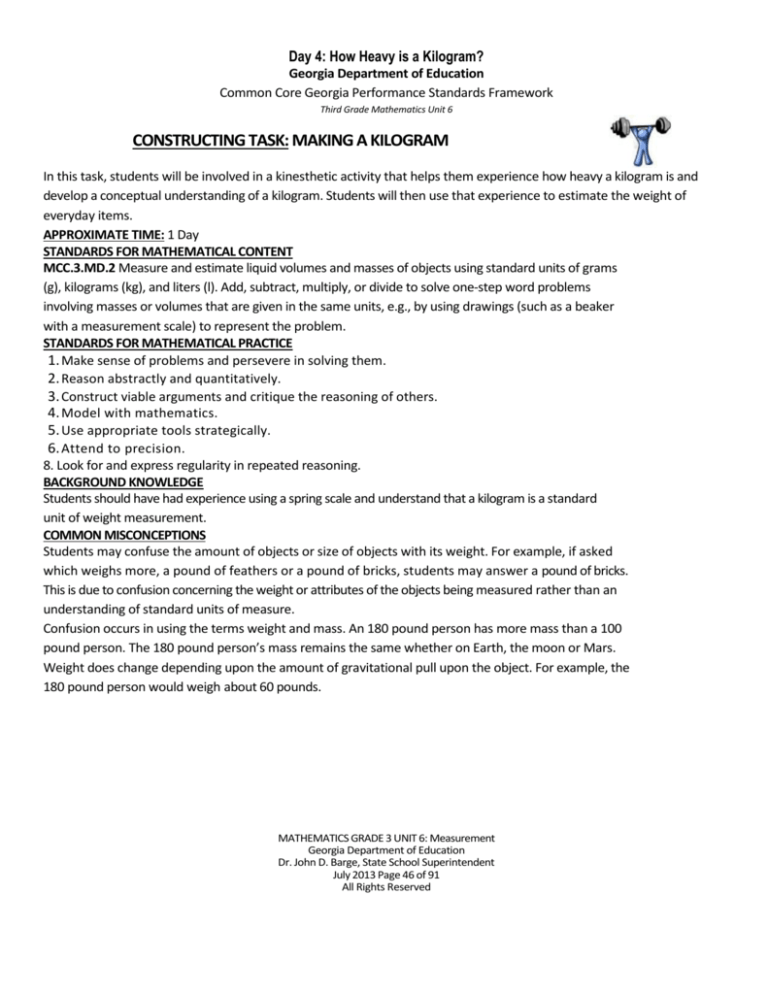
Day 4: How Heavy is a Kilogram?
Georgia Department of Education
Common Core Georgia Performance Standards Framework
Third Grade Mathematics Unit 6
CONSTRUCTING TASK: MAKING A KILOGRAM
In this task, students will be involved in a kinesthetic activity that helps them experience how heavy a kilogram is and
develop a conceptual understanding of a kilogram. Students will then use that experience to estimate the weight of
everyday items.
APPROXIMATE TIME: 1 Day
STANDARDS FOR MATHEMATICAL CONTENT
MCC.3.MD.2 Measure and estimate liquid volumes and masses of objects using standard units of grams
(g), kilograms (kg), and liters (l). Add, subtract, multiply, or divide to solve one-step word problems
involving masses or volumes that are given in the same units, e.g., by using drawings (such as a beaker
with a measurement scale) to represent the problem.
STANDARDS FOR MATHEMATICAL PRACTICE
1. Make sense of problems and persevere in solving them.
2. Reason abstractly and quantitatively.
3. Construct viable arguments and critique the reasoning of others.
4. Model with mathematics.
5. Use appropriate tools strategically.
6. Attend to precision.
8. Look for and express regularity in repeated reasoning.
BACKGROUND KNOWLEDGE
Students should have had experience using a spring scale and understand that a kilogram is a standard
unit of weight measurement.
COMMON MISCONCEPTIONS
Students may confuse the amount of objects or size of objects with its weight. For example, if asked
which weighs more, a pound of feathers or a pound of bricks, students may answer a pound of bricks.
This is due to confusion concerning the weight or attributes of the objects being measured rather than an
understanding of standard units of measure.
Confusion occurs in using the terms weight and mass. An 180 pound person has more mass than a 100
pound person. The 180 pound person’s mass remains the same whether on Earth, the moon or Mars.
Weight does change depending upon the amount of gravitational pull upon the object. For example, the
180 pound person would weigh about 60 pounds.
MATHEMATICS GRADE 3 UNIT 6: Measurement
Georgia Department of Education
Dr. John D. Barge, State School Superintendent
July 2013 Page 46 of 91
All Rights Reserved
Georgia Department of Education
Common Core Georgia Performance Standards Framework
Third Grade Mathematics Unit 6
ESSENTIAL QUESTIONS
About how heavy is a kilogram?
What items in the classroom weigh close to a kilogram?
MATERIALS
“Making a Kilogram” student recording sheet
1 kilogram weight ( a liter of water weighs about one kilogram)
Cloth or paper bags (one per student)
Sand, aquarium gravel, blocks, cubes, beans, etc. for students to use when filling bags
Spring scale
Note
A great amount of material (sand, aquarium gravel, blocks, cubes, and/or beans) will be needed if
every student is going to create their own kilogram. A kilogram weighs about 2.2 pounds so you will
need at least 50 pounds of material for 20 students. In order to allow students to experiment when
creating one kilogram, there should be more than one kilogram of material per student. If you do
not have enough material, students may work in pairs or triplets to create a kilogram. This can also
be accomplished using empty student backpacks, with classroom items as filler to create the 1
kilogram weights.
GROUPING
Whole Group/Individual Task
NUMBER TALKS
By now number talks should be incorporated into the daily math routine. Continue utilizing the different
strategies in number talks and revisiting them based on the needs of the students.
TASK DESCRIPTION, DEVELOPMENT AND DISCUSSION (SMP 1, 2, 3, 4, 5, 6 and 8) Students will follow the
directions below from the “Making a Kilogram” student recording sheet.
Part I
To introduce this task, have students think about the heaviness of a kilogram as you pass around an
example of an one kilogram weight. Students are to try to remember how heavy the one kilogram
weight feels.
Now have students create a one kilogram weight using a bag and provided materials. Do not allow
students to use a scale when creating bag weights.
MATHEMATICS GRADE 3 UNIT 6: Measurement
Georgia Department of Education
Dr. John D. Barge, State School Superintendent
July 2013 Page 47 of 91
All Rights Reserved
Georgia Department of Education
Common Core Georgia Performance Standards Framework
Third Grade Mathematics Unit 6
Part II
Students how empty and refill their bags at least three times, to determine if bag weighs more than,
less than, or equal to one kilogram. Using mathematical words to describe whether the bag has more
than, less than, or equal weight to a kilogram is an important part of this activity. Make sure the students
don’t skip this step. Record your results in the chart below.
FORMATIVE ASSESSMENT QUESTIONS
● How can your created kilogram weight be used to measure items? ●
Why is it important to have a standard unit of weight?
● What everyday items could be measured using kilograms?
DIFFERENTIATION
Extension
● Sometimes it is helpful to have referents for weights. Ask students to create a poster of
common everyday objects that weigh a specific amount. (Be careful about weights
indicated on a product package as that will not include the weight of the container, which
may be significant in some situations. This would be a good discussion to have with
students.)
Intervention
● Have students work in pairs to accomplish this task.
TECHNOLOGY CONNECTION
http://www.mathsisfun.com/measure/metric-mass.html Provides some background on metric
measures and lists items that weigh about one kilogram.
MATHEMATICS GRADE 3 UNIT 6: Measurement
Georgia Department of Education
Dr. John D. Barge, State School Superintendent
July 2013 Page 48 of 91
All Rights Reserved
Name
Date
Georgia Department of Education
Common Core Georgia Performance Standards Framework
Third Grade Mathematics Unit 6
Making a Kilogram
1. Think about the heaviness of the kilogram provided by your teacher. You
are now to create a bag you think will weigh about 1 kilogram. Do not use a scale
to create your bag!
2. Determine if your bag weighs more than, less than, or equal to one kilogram. Record your results in
the chart below.
Actual Weight
of My Bag
Attempt #1
More Than, Less Than, or Equal to one
Kilogram
My bag weighs
a kilogram.
My bag weighs
a kilogram.
My bag weighs
a kilogram.
Attempt #2
Attempt #3
Look at the actual weights of your bag. What could you do if you wanted to determine the weight
of three bags with the same exact weight? Explain your thinking.
MATHEMATICS GRADE 3 UNIT 6: Measurement
Georgia Department of Education
Dr. John D. Barge, State School Superintendent
July 2013 Page 49 of 91
All Rights Reserved

